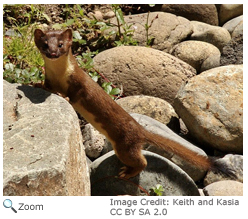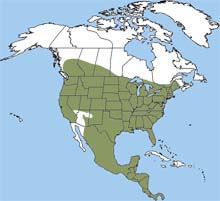Characteristics
 The long-tailed weasel has a small head with long whiskers, a long body and neck and short legs. Its tail has a black tip. It has brown fur on the upper part of its body and white to yellow fur on its undersides. In the northern parts of its range, it turns white in the winter. Long-tailed weasels in the Southwest have a white mask. The long-tailed weasel has a small head with long whiskers, a long body and neck and short legs. Its tail has a black tip. It has brown fur on the upper part of its body and white to yellow fur on its undersides. In the northern parts of its range, it turns white in the winter. Long-tailed weasels in the Southwest have a white mask.
Range
 The long-tailed weasel is found in most of the United States, except for parts of southeast California and Nevada and most of Arizona.It is also found in Canada, Mexico, and central and South America. The long-tailed weasel is found in most of the United States, except for parts of southeast California and Nevada and most of Arizona.It is also found in Canada, Mexico, and central and South America.
Habitat
The long-tailed weasel lives in a wide variety of habitats including woodlands, thickets, open areas and farmland. It usually lives near a water source.
Diet
The long-tailed weasel is a carnivore. It has a very high rate of metabolism and eats about 40% of its body weight every day! Most of its diet is made up of small mammals like mice, voles, rabbits, gophers and chipmunks. It will occasionally eat birds and insects. It crushes its prey's skull with its canines. It uses scent and sound to track its prey. Its long, thin body makes it easy for it to follow prey into burrows.
|
|
Life Cycle
The long-tailed weasel mates in the summer, but the fertilized eggs don't begin to develop until about 27 days before the babies are born. The female gives birth in the spring. Most litters have between 4-8 young. The babies are born blind with a light covering of fur. Their eyes open and they are weaned when they are about 36 days old. The female brings them food when they are weaned and later takes them hunting. The babies leave their mother when they are between seven and eight weeks old.
Behavior
The long-tailed weasel is a solitary animal, except during mating season. It lives in the abandoned burrows other mammals, in rotting logs or under tree roots or rocks. Its nest is made of grass and leaves and lined with fur. The long-tailed weasel is most active in the night, but it also comes out in the day. It does not hibernate. The long-tailed weasel can climb trees and it is a good swimmer. It uses lots of different vocalizations including squeals, squeaks, trills and purrs. It also releases a strong smelling musk during mating season and when it is frightened. It is very aggressive when its territory is invaded.
|